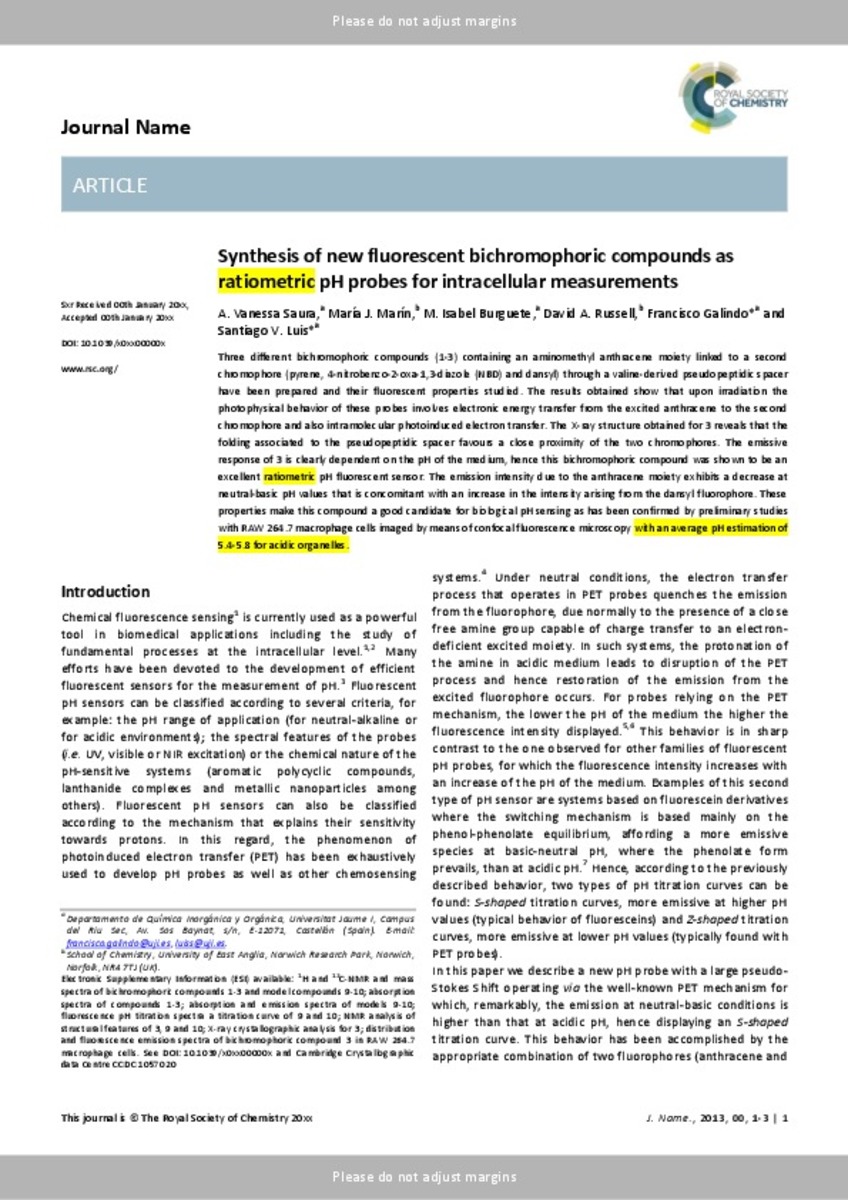Mostrar el registro sencillo del ítem
The synthesis of new fluorescent bichromophoric compounds as ratiometric pH probes for intracellular measurements
| dc.contributor.author | Saura Centelles, Ana Vanessa | |
| dc.contributor.author | Marín, María J. | |
| dc.contributor.author | Burguete, M. Isabel | |
| dc.contributor.author | Russell, David A. | |
| dc.contributor.author | Galindo, Francisco | |
| dc.contributor.author | Luis, Santiago V. | |
| dc.date.accessioned | 2016-05-06T14:51:02Z | |
| dc.date.available | 2016-05-06T14:51:02Z | |
| dc.date.issued | 2015 | |
| dc.identifier.citation | Saura, Vanessa, Marin Altaba, Maria, Burguete, M. Isabel, Russell, David, Galindo, Francisco and Luis, Santiago V. (2015) Synthesis of new fluorescent bichromophoric compounds as ratiometric pH probes for intracellular measurements. Organic & Biomolecular Chemistry, 13 (28). pp. 7736-7749. ISSN 1477-0520 | ca_CA |
| dc.identifier.issn | 1477-0520 | |
| dc.identifier.issn | 1477-0539 | |
| dc.identifier.uri | http://hdl.handle.net/10234/159373 | |
| dc.description.abstract | Three different bichromophoric compounds (1–3) containing an aminomethyl anthracene moiety linked to a second chromophore (pyrene, 4-nitrobenzo-2-oxa-1,3-diazole (NBD) and dansyl) through a valinederived pseudopeptidic spacer have been prepared and their fluorescent properties studied. The results obtained show that upon irradiation the photophysical behavior of these probes involves electronic energy transfer from the excited anthracene to the second chromophore and also intramolecular photoinduced electron transfer. The X-ray structure obtained for 3 reveals that the folding associated with the pseudopeptidic spacer favours a close proximity of the two chromophores. The emissive response of 3 is clearly dependent on the pH of the medium, hence this bichromophoric compound was shown to be an excellent ratiometric pH fluorescent sensor. The emission intensity due to the anthracene moiety exhibits a decrease at neutral–basic pH values that is concomitant with an increase in the intensity arising from the dansyl fluorophore. These properties make this compound a good candidate for biological pH sensing as has been confirmed by preliminary studies with RAW 264.7 macrophage cells imaged by means of confocal fluorescence microscopy with an average pH estimation of 5.4–5.8 for acidic organelles. | ca_CA |
| dc.description.sponsorShip | Spanish Ministerio de Economia y Competitividad (MINECO) CTQ2012-38543-C03-01 Generalitat Valenciana PROMETEO/2012/020 Universitat Jaume I P1 1B2012-41 School of Chemistry, University of East Anglia | ca_CA |
| dc.format.extent | 14 p. | ca_CA |
| dc.language.iso | eng | ca_CA |
| dc.publisher | Royal Society of Chemistry | ca_CA |
| dc.relation.isPartOf | Organic & Biomolecular Chemistry, 2015, 13, 7736–7749 | ca_CA |
| dc.rights | "Reproduced by permission of The Royal Society of Chemistry". This journal is © The Royal Society of Chemistry 2015 | ca_CA |
| dc.rights.uri | http://rightsstatements.org/vocab/InC/1.0/ | * |
| dc.subject | photoinduced electron-transfer | ca_CA |
| dc.subject | acidic organelles | ca_CA |
| dc.subject | energy-transfer | ca_CA |
| dc.subject | live cells | ca_CA |
| dc.subject | molecular logic | ca_CA |
| dc.subject | cholic-acid | ca_CA |
| dc.subject | far-red | ca_CA |
| dc.subject | sensors | ca_CA |
| dc.subject | emission | ca_CA |
| dc.subject | dyads | ca_CA |
| dc.title | The synthesis of new fluorescent bichromophoric compounds as ratiometric pH probes for intracellular measurements | ca_CA |
| dc.type | info:eu-repo/semantics/article | ca_CA |
| dc.identifier.doi | http://dx.doi.org/10.1039/C5OB00704F | |
| dc.rights.accessRights | info:eu-repo/semantics/openAccess | ca_CA |
| dc.relation.publisherVersion | http://pubs.rsc.org/en/content/articlelanding/2015/ob/c5ob00704f#!divAbstract | ca_CA |
| dc.type.version | info:eu-repo/semantics/submittedVersion |
Ficheros en el ítem
Este ítem aparece en la(s) siguiente(s) colección(ones)
-
QUIO_Articles [692]
Articles de publicacions periòdiques







